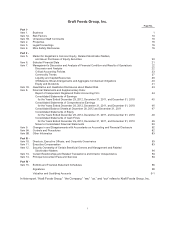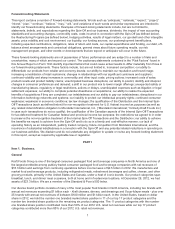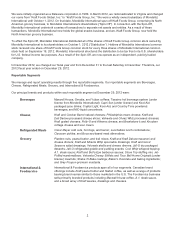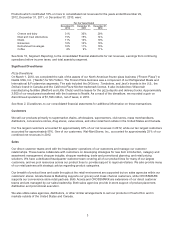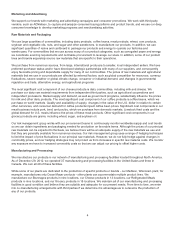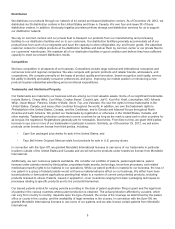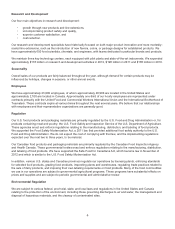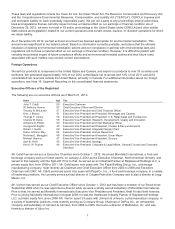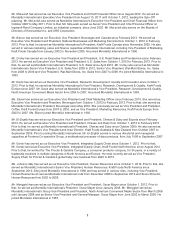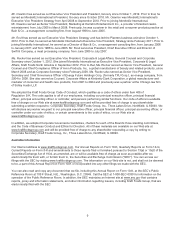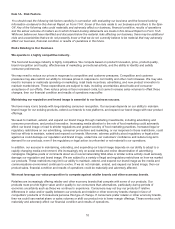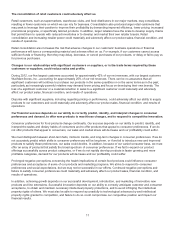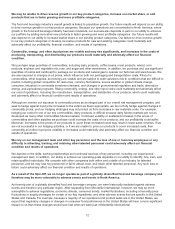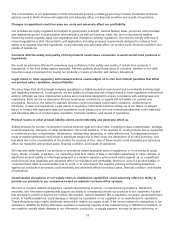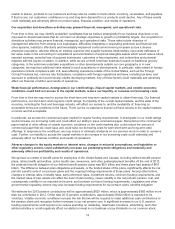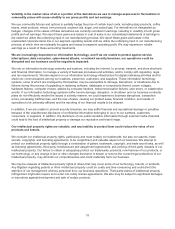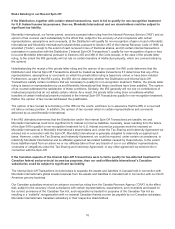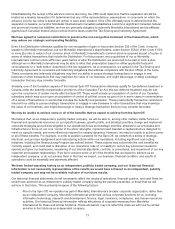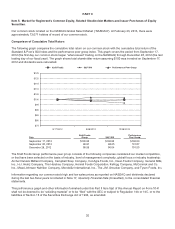Kraft 2012 Annual Report Download - page 12
Download and view the complete annual report
Please find page 12 of the 2012 Kraft annual report below. You can navigate through the pages in the report by either clicking on the pages listed below, or by using the keyword search tool below to find specific information within the annual report.Item 1A. Risk Factors.
You should read the following risk factors carefully in connection with evaluating our business and the forward-looking
information contained in this Annual Report on Form 10-K. Some of the risks relate to our business and others to the Spin-
Off. Any of the following risks could materially and adversely affect our business, financial condition, results of operations
and the actual outcome of matters as to which forward-looking statements are made in this Annual Report on Form 10-K.
While we believe we have identified and discussed below the material risks affecting our business, there may be additional
risks and uncertainties that we do not presently know or that we do not currently believe to be material that may adversely
affect our business, financial condition or results of operations in the future.
Risks Relating to Our Business
We operate in a highly competitive industry.
The food and beverage industry is highly competitive. We compete based on product innovation, price, product quality,
brand recognition and loyalty, effectiveness of marketing, promotional activity, and the ability to identify and satisfy
consumer preferences.
We may need to reduce our prices in response to competitive and customer pressures. Competition and customer
pressures may also restrict our ability to increase prices in response to commodity and other cost increases. We may also
need to increase or reallocate spending on marketing, retail trade incentives, advertising, and new product innovation to
maintain market share. These expenditures are subject to risks, including uncertainties about trade and consumer
acceptance of our efforts. If we reduce prices or face increased costs, but cannot increase sales volumes to offset those
changes, then our financial condition and results of operations may suffer.
Maintaining our reputation and brand image is essential to our business success.
We have many iconic brands with long-standing consumer recognition. Our success depends on our ability to maintain
brand image for our existing products, extend our brands to new platforms, and expand our brand image with new product
offerings.
We seek to maintain, extend, and expand our brand image through marketing investments, including advertising and
consumer promotions, and product innovation. Increasing media attention to the role of food marketing could adversely
affect our brand image or lead to stricter regulations and greater scrutiny of food marketing practices. Increased legal or
regulatory restrictions on our advertising, consumer promotions and marketing, or our response to those restrictions, could
limit our efforts to maintain, extend and expand our brands. Moreover, adverse publicity about regulatory or legal action
against us could damage our reputation and brand image, undermine our customers’ confidence and reduce long-term
demand for our products, even if the regulatory or legal action is unfounded or not material to our operations.
In addition, our success in maintaining, extending, and expanding our brand image depends on our ability to adapt to a
rapidly changing media environment. We increasingly rely on social media and online dissemination of advertising
campaigns. Negative posts or comments about us on social networking Web sites or similar online activity could seriously
damage our reputation and brand image. We are subject to a variety of legal and regulatory restrictions on how we market
our products. These restrictions may limit our ability to maintain, extend, and expand our brand image as the media and
communications environment continues to evolve. If we do not maintain, extend, and expand our brand image, then our
product sales, financial condition and results of operations could be materially and adversely affected.
We must leverage our value proposition to compete against retailer brands and other economy brands.
Retailers are increasingly offering retailer and other economy brands that compete with some of our products. Our
products must provide higher value and/or quality to our consumers than alternatives, particularly during periods of
economic uncertainty such as those we continue to experience. Consumers may not buy our products if relative
differences in value and/or quality between our products and retailer or other economy brands change in favor of
competitors’ products or if consumers perceive this type of change. If consumers prefer retailer or other economy brands,
then we could lose market share or sales volumes or shift our product mix to lower margin offerings. These events could
materially and adversely affect our financial condition and results of operations.
10


